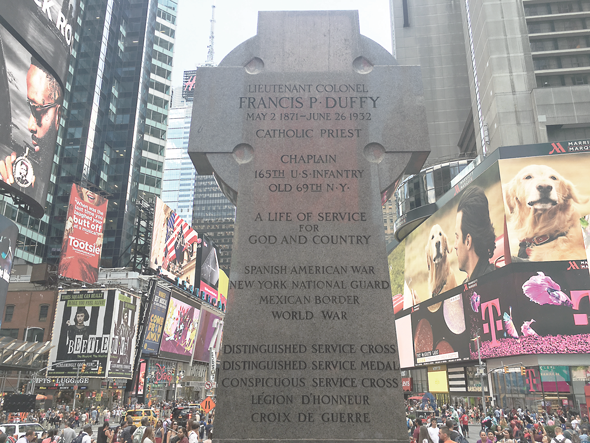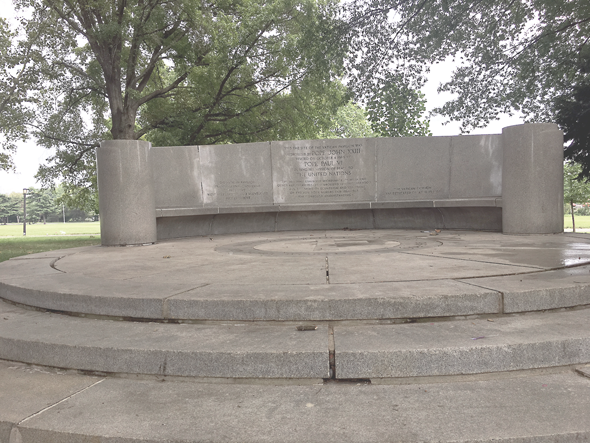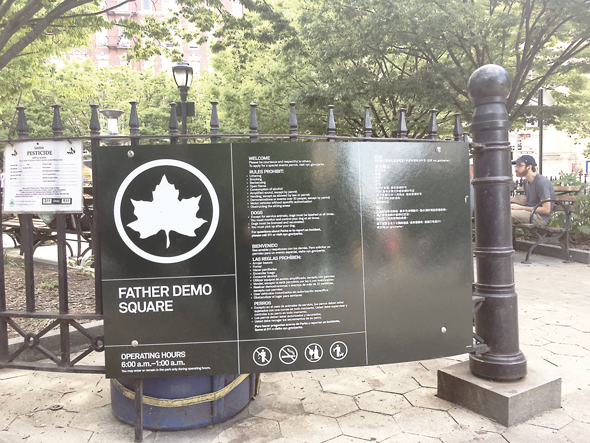Story & Photos by Alex Moyen
NEW YORK —Tourists typically visit New York City to stroll through Washington Square Park or down Broadway. They tend to catch a Yankees game and a play. A trip isn’t complete without sunbathing in Central Park or basking in the lights of Times Square. However, the “Big Apple,” or the less humble, “Center of the Universe,” is home to many monuments, parks and sculptures with a religious backstory, worthy of both tourists’ and New Yorkers’ attention. The city is filled with Catholic symbols and memorials cemented into the cobblestoned history of the five boroughs that even the proudest Knickerbocker might not be familiar with.
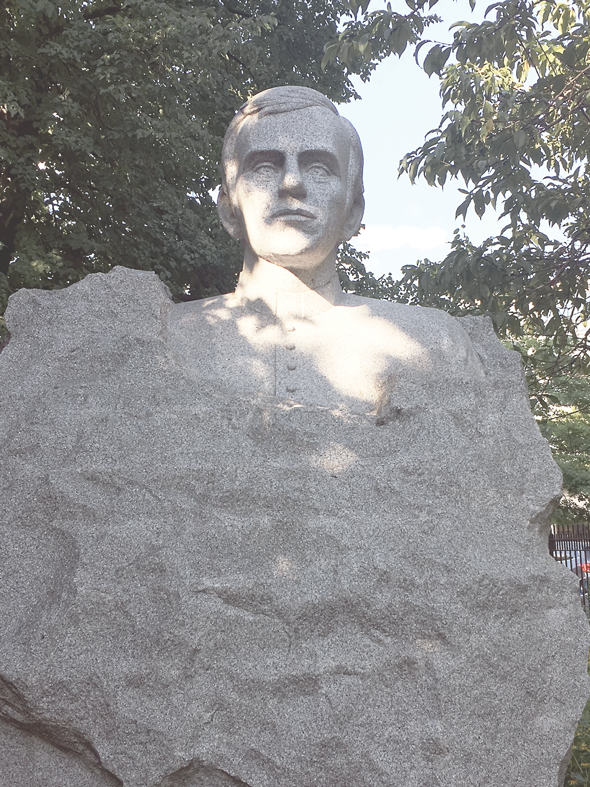
1. Located on Nassau Avenue in the neighborhood of Greenpoint is Father Popieluszko Square.
The small square’s monument dedicated to the Polish priest is right in the center, and the bust, complemented by surrounding trees and flowers, in the back. Neighboring the square is McCarren Park, which it was once a part of, and a few restaurants and markets. The park also has a flagpole to honor those who have sacrificed their lives.
Father Jerzy Popieluszko encouraged people to demonstrate peaceful resistance to the communist regime in his homilies, which were broadcasted on the radio. He also worked as chaplain to the workers of movement and labor union Solidarity, which was instrumental in the fall of communism in Poland.
Communist authorities relentlessly tried to kill Father Popieluszko. Their first attempt was the bombing of his home, which he escaped unscathed. A year later they arrested him under pretenses, but under the pressure of the Catholic Church and the Polish people, soon released him. On Oct. 13, 1984, they unsuccessfully tried to kill him again during traffic.
Unfortunately, they had a backup plan.
On Oct. 19, they lured him in by pretending to need help with their broken-down car on the side of the road. They proceeded to beat him to death, tie rocks to his body and throw him in the Vistula River. His body was recovered on Oct. 30, 1984.
In 1985, New York’s City Council named the square after Father Popieluszko and in 1990 a granite bust was dedicated in the park by Stanislaw Lutostanski. Every year on Oct. 19, thousands come to the park to commemorate and honor Father Popieluszko’s life.
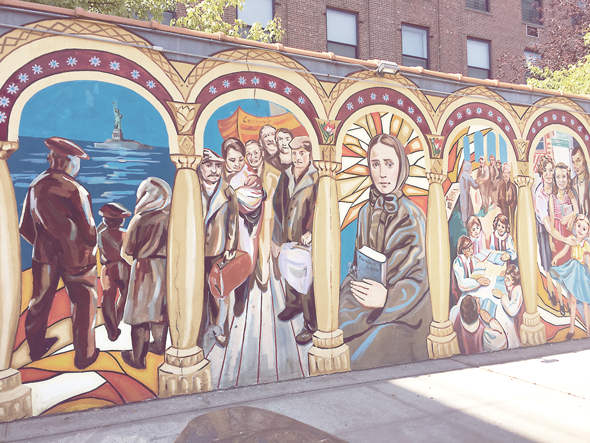
2. Known for bringing in the new while keeping a flair for the old, Carroll Gardens is home to the Mother Cabrini mural. In 2012, the mural brought life to the otherwise dull 500 Hicks Street, with its pop of color and portrayal of a charitable woman. It is hard to miss; however, people park their cars and walk past it, barely noticing the beauty.
Mother Cabrini, an Italian immigrant who came to America without speaking any English, made an impact by helping others just like her. When she came to Brooklyn in 1892, she opened St. Charles School to educate the children of her immigrant co-workers.
She has expanded her ministry to different parts of the country. She founded 67 schools, orphanages, hospitals and parish ministries before her death at age 67. She was canonized in 1946 and named the “Patroness of Immigrants.”
The mural depicts a painting of immigrants staring off hopefully at the Statue of Liberty, followed by immigrants coming off a boat, Mother Cabrini, children in a classroom, and a family, each of them divided by pillars.
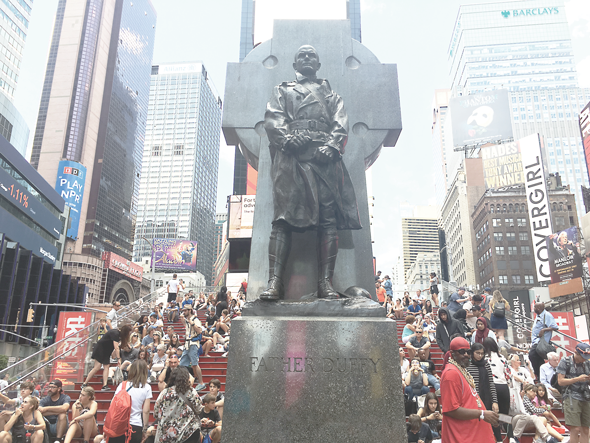
3. Times Square is known as the center of New York City. It is the typical tourist destination with its entertainment scene and picturesque sites. Many love to take pictures on the “red steps,” but chances are they don’t notice that they are sitting in Duffy Square, home to the almost 17-foot-tall monument of Father Francis Duffy.
The bronze statue of Father Duffy stands at about 8 feet tall on a 17-foot-tall granite Celtic cross. On the back of the Celtic cross is an inscription of the life and death of Father Duffy and his accomplishments. Donated by the Father Duffy Memorial Committee and Works Progress Administration, the monument stands tall in front of the famous red steps of Times Square.
A decorated chaplain and pastor, Father Duffy, was ordained a priest in Oct. 1896. He later started his military service in the Spanish-American War of 1898. There, he served as a first lieutenant and chaplain of the Fighting 69th Infantry.
Father Duffy served as founding pastor of Our Savior Parish in the Bronx in 1912 and within this parish, created a place for the church and school. He served there until he was deployed for war again in 1918. When he returned, he was named pastor of Holy Cross Parish in Manhattan.
He received the Distinguished Service Cross, Distinguished Service Medal, and Conspicuous Service Cross. He also received the Légion d’Honneur and the Croix de Guerre awards. Father Duffy is the most highly decorated cleric in the history of the U.S. Army.
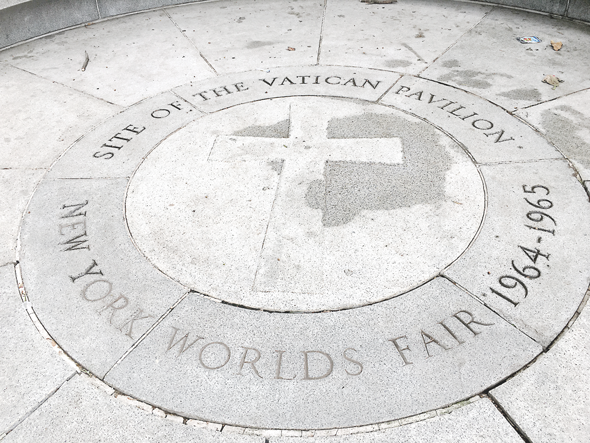
4. Known for its enormous Unisphere, Flushing Meadows Corona Park is one of New York’s most well-known and iconic parks. Visitors can take part in a diverse array of sports, scenic trails and historic walks.
Near Corona’s Maloof State Park, the original spot for the Vatican Pavilion, resides the Vatican Shrine. Dedicated in 1964, this granite shrine is easy to miss; the maps in the park make no indication of its existence and it’s especially hard to find in the winter because of the snow.
However, once found, the shrine proves to be a hidden gem. Near the Avenue of Peace and far off from the park, it’s the perfect quiet spot to sit and relax and enjoy the scenery.
On one of the benches is inscribed:
“This, the site of the Vatican Pavilion was authorized by Pope John XXIII, visited on Oct. 4, 1965, by Pope Paul VI during his mission of peace to the United Nations. The building exhibited Michelangelo’s Pieta and other art treasures. It symbolized the brotherhood of man, the spirit of ecumenism, and the theme of the New York World’s Fair 1964-1965: “Peace through understanding.”
Although at times unnoticeable, once seen, these monuments, shrines and statues tell the story of God-loving people. New York has more to offer from its St. Patrick’s Cathedral on Fifth Avenue to the Shrine of Our Lady of Mount Carmel in Middletown that tourists are more than welcome to visit.

5. Bleecker Street is home to the second-best pizza shop in the country, Bleecker Street Pizza. Famous for its Parmigiano-Reggiano cheese shipped directly from Italy and “Nonna Maria” pies, tourists from all over come to have a bite. But just a few blocks over is the beautiful piazza, Father Demo Square.
This square, with its picturesque fountain in its center, is a designated quiet area perfect for sitting down and eating at Bleecker Street Pizza. Surrounding the square are markets, Italian eateries, small apartment buildings and busy streets.
Father Antonio Demo immigrated from Italy to Boston in 1896 to do missionary work. In 1899, he went to New York to serve as assistant pastor of Our Lady of Pompei, across the street from the square, and in 1900, was appointed as pastor.
Father Demo was known for being involved in the community. He accommodated the working immigrants by reorganizing the church schedule so it didn’t conflict with their work, working with charities and raising funds.

